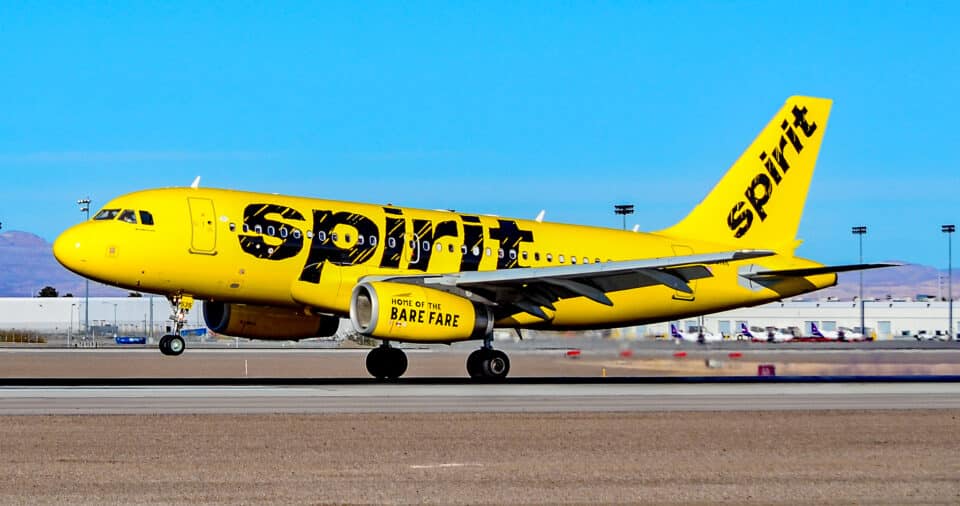Aerospace
JetBlue wins Spirit takeover battle with $3.8 billion deal
Breaking News : JetBlue wins Spirit takeover battle with $3.8 billion deal. After Spirit Airlines terminated its merger arrangement with Frontier Airlines, JetBlue Airways came to an agreement to acquire the affordable carrier.

NEW YORK & MIRAMAR, Fla.–(BUSINESS WIRE)– JetBlue Airways Corporation (“JetBlue”) (NASDAQ: JBLU) and Spirit Airlines, Inc. (“Spirit”) (NYSE: SAVE) today announced that their boards of directors have approved a definitive merger agreement under which JetBlue will acquire Spirit for $33.50 per share in cash, including a prepayment of $2.50 per share in cash payable upon Spirit stockholders’ approval of the transaction and a ticking fee of $0.10 per month starting in January 2023 through closing, for an aggregate fully diluted equity value of $3.8 billion and an adjusted enterprise value of $7.6 billion.
Increases JetBlue’s relevance and offers consumers more choices by leveraging the airlines’ complementary networks and fleets
- The airline will offer its combined 77 million customers more options and choices.
- JetBlue plans to bring the JetBlue Experience to all aircraft, offering JetBlue’s unique combination of low fares and award-winning service to more customers.
- The acquisition will accelerate JetBlue’s organic growth plan with 1,700+ daily flights to more than 125 destinations in 30 countries based on December 2022 schedules.
- The acquisition will increase relevance for JetBlue in certain key focus cities (Fort Lauderdale, Orlando, San Juan, and Los Angeles) as well as Big Four airline hubs (Las Vegas, Dallas, Houston, Chicago, Detroit, Atlanta, and Miami).
- The combined airline will have a fleet of 458 aircraft on a pro forma basis and an order book of over 300 Airbus aircraft with fuel-efficient, lower-carbon new engine option, or neo, engines, providing increased flexibility and efficiency while mitigating the risk of limited availability of aircraft.
Brings together the best of both airlines’ cultures and values to create job growth and career opportunities for Crewmembers and Team Members
- The combined airline will provide more career growth options, broader travel benefits, more opportunities to make a difference in the communities JetBlue and Spirit serve, and a deeper bench of intellectual capital to support the future growth of the airline.
- The mission-driven, customer-centric airline of more than 34,000 crewmembers will further job growth, including planned insourcing of Spirit’s outsourced operations in cities where JetBlue has its own Crewmembers.
- JetBlue will expand its no furlough commitment to Spirit’s Team Members as they are welcomed into JetBlue after closing.
- JetBlue will ensure a smooth transition for Spirit’s corporate Team Members by retaining a Fort Lauderdale support center, in addition to JetBlue’s other support centers.
- JetBlue is committed to working with labor leaders at both airlines and JetBlue values committee representatives to ensure the combination supports the needs of those that operate the airline.

Aerospace
Boeing Transfers Rocket Stage to NASA, Paving Way for Human Moon Mission

Boeing has achieved a significant milestone by providing NASA with the second core stage of the Space Launch System (SLS) rocket.
This crucial component, crafted at NASA’s Michoud Assembly Facility (MAF), is set to propel the Artemis II crew into lunar orbit, marking humanity’s return to deep space after a 50-year hiatus.
The monumental Boeing-built rocket stage, the largest element of the Artemis II mission, will embark on a journey aboard the Pegasus barge, traveling 900 miles to NASA’s Kennedy Space Center.
Comparison of two legendary aircraft B777x vs B747 aircraft:Click here
Upon arrival, it will be meticulously integrated with other essential Artemis II components, including the upper stage, solid rocket boosters, and NASA’s Orion spacecraft within the iconic Vehicle Assembly Building. This intricate integration process is a vital step toward the eagerly anticipated Artemis II launch, slated for 2025.
“Boeing-built products helped land humankind on the moon in 1969, and we’re proud to continue that legacy through the Artemis generation,” remarked Dave Dutcher, vice president and program manager for Boeing’s SLS program. “Together, with NASA and our industry partners and suppliers, we are building the world’s most capable rocket and paving the way to deep space through America’s rocket factory in New Orleans.”
NASA, Lockheed Martin Reveal X-59 Quiet Supersonic Aircraft:Click here
The delivery of Core Stage 2 marks a significant achievement in the evolution of the SLS rocket. Towering over 200 feet and powered by four RS-25 engines, this core stage, coupled with two solid-fueled booster rockets, will generate a staggering 8.8 million pounds of thrust. This immense power is crucial to launching Artemis II and future missions into the vast expanse of space.
The SLS rocket stands unparalleled in its capability to transport both crew and substantial cargo to the moon and beyond in a single launch. Its extraordinary capacity will facilitate the delivery of human-rated spacecraft, habitats, and scientific missions to destinations including the moon and Mars, ushering in a new era of space exploration.
-

 Travel1 week ago
Travel1 week agoAir India to Expand US Operations with Three New Routes After a Decade
-

 Travel2 weeks ago
Travel2 weeks agoWhy We Should Avoid These Stamps in a Passport
-

 Airlines1 month ago
Airlines1 month agoInvestigations Reveal Fake Chinese Titanium in Boeing and Airbus Jets
-

 Tech4 weeks ago
Tech4 weeks agoChina’s CATL Plans 1,800-Mile Electric Plane Launch by 2027
-

 Airport3 days ago
Airport3 days agoTop 10 Largest Airports in the World by Size
-

 Aerospace4 weeks ago
Aerospace4 weeks agoChina’s Fighter Jets Turn Wings into Autonomous Drones
-

 Airlines4 days ago
Airlines4 days agoAir India Rolls Out A350s for Delhi-New York JFK and Newark Routes
-

 Defence3 weeks ago
Defence3 weeks agoBoeing Enhances Chinook with New Engines and Block II Upgrades at $96 Million







